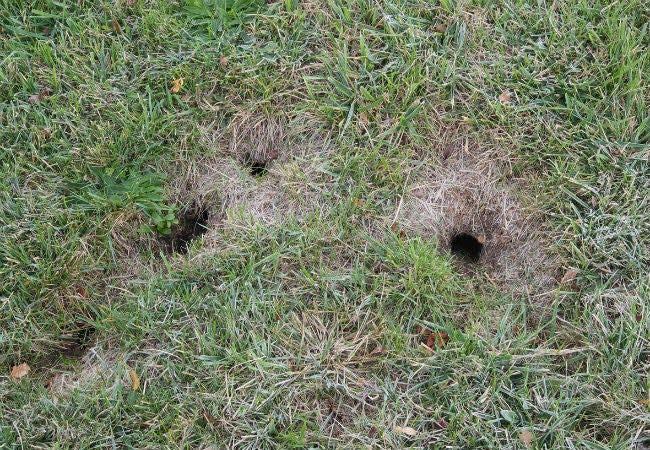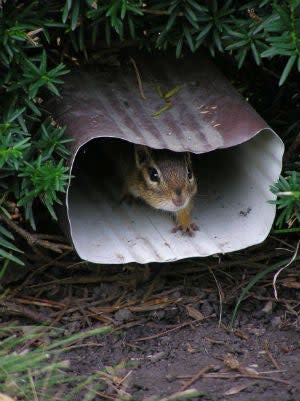How To: Get Rid of Chipmunks

Surely one of the cuter rodents you’ll ever counter, chipmunks are also among the most destructive. These small, striped natives of North America and Asia are omnivores that devour everything from beneficial insects to buds, bulbs, and other garden plantings. Potentially worse, while they run like lightning to avoid humans, their underground burrows can destabilize the foundation of your house.
Fortunately, you can discourage and—if necessary—humanely remove the critters from your property. Start with simple, natural deterrent methods and proceed to stricter—yet still humane—measures if need be to send the little guys packing. Below, you'll find five key strategies for how to get rid of chipmunks running around in your yard.

Photo: istockphoto.com
Identify an infestation.
Chipmunks are so shy and so quick, you may not even notice them in your yard. But if you’ve seen evidence of munching in your garden, start sleuthing. Look for holes in your lawn, tiny footprints (four toes in front, five in back), and piles of seed shells under your birdfeeder.
Roll up the welcome mat.

Photo: istockphoto.com
To make your property unattractive to chipmunks, keep your garden tidy by cleaning up windfall from fruit trees and berry bushes. Also, consider putting in plants like garlic and daffodils that act as natural repellents. Bag and dispose of small rocks, vines, and clippings where chipmunks may hide. Keep bird feeders high off the ground and away from fences, porch banisters, and other potential chipmunk paths. To discourage the critters from approaching your home’s foundation, avoid shrubs and low rock boundaries near the house, which provide shelter and transportation for critters.
Use a combination of chipmunk repellents.
There are four main types of chipmunk repellents, which can be used together and for different purposes:
Natural repellents: Ask your barber or hairstylist for a bag of hair clippings and sprinkle these around your garden. The human smell frightens chipmunks and other pests away yet is perfectly harmless—in fact, the nitrogen in human hair breaks down slowly and may offer your plants a natural fertilizer boost, according to a study at Mississippi State University that was published in the journal HortTechnology.
Electronic repellents: An electronic repellent system uses ultrasonic pulses or sprays of water to get rid of chipmunks as well as deer, raccoons, rabbits, and squirrels that may be drawn to your lawn. A high-quality, non-toxic, and top-rated electronic pest repeller costs between $20 and $30 and can cover 900 to 1,200 square feet via a safe, consistent power source: typically an AC 110 volt plug outlet or AA batteries (view example on Amazon). Keep in mind, however, that sound waves and water sprays won’t dislodge chipmunk nests and burrows underground.
Liquid repellents: Purchase a non-toxic commercial product like Rodent Defense Spray (available on Amazon) or make a DIY solution of one quart of water boiled with two tablespoons of cayenne and, once cool, two tablespoons of olive oil. Store in a labeled spray bottle and shake well before spraying directly on infested areas. Reapplication and patience are essential, as it may take a bit of time (and favorable weather conditions) for chipmunks to come into direct contact with the distasteful stuff. Fall gardening tip: Protect vulnerable tulip bulbs by dipping them into a liquid repellent before planting.
Dry repellents: Dry products are longer-lasting than liquid sprays and will help prevent chipmunk burrowing. Create barriers to access by sprinkling granular repellents in key areas. Use a product like Shake Away (available on Amazon)—which doesn’t kill chipmunks or other pests—in attics, near house foundations, around flowerbeds, and along garden paths. Or simply shake a healthy sprinkle of cayenne pepper on affected areas.
RELATED: A Dozen 10-Minute DIYs for a Pest-Free Home
Enforce good fencing.
The Humane Society suggests finding gentler ways of living with chipmunks while preventing them from nibbling our plants. Consider installing an L-shaped barrier of mesh fencing around the base of foundations, fences, porches, and other walls. Choose a gravel border instead of box shrubs. Protect flower bulbs by planting them in bulb cages, available at home centers and gardening supply stores.
Try trapping.

Photo: istockphoto.com
Humane traps catch chipmunks without killing them so you can then resettle them miles away from your property. Choose one- or two-door traps—typically 10 to 20 inches long—for chipmunks (one-door traps tend to be simpler to operate and are often used by professionals), and wear gloves when setting the traps, as any hint of human scent will spook your quarry. Place traps in areas you’ve identified as prime chipmunk territory: your attic, garden shed, along fences and walls, and near the house foundations. Peanuts, sunflower seeds, and peanut butter make excellent bait, which you place directly to the trigger plate. Set the trap according to instructions and check it often so you can release the rodents promptly.
Note: Different localities have different laws about trapping and relocating wild animals, so double-check your city’s wildlife ordinances first before using traps to get rid of the chipmunks running loose in your lawn.